The Misak Indigenous People, Colombia: “We don’t want a development plan. What we want is a Life Plan”
The Misak are an Indigenous people whose territory is in Cauca, high in the Andes mountains in Colombia. During Spanish colonial rule, they lost large parts of their territory, but in he 1980s they started a process of reclaiming their land. Eventually they gained formally recognised land rights.
Since then, the Misak have developed their Life Plan as a way of ensuring their own self-determined development. Life Plans represent Indigenous Peoples’ opportunity to decide their vision of the future as a community.
Their territory covers about 15,000 hectares. They have farmed the land, which is too high for trees to grow, for hundreds of years. More than two-thirds of the land is sacred sites.
Life Mosaic’s video “Life Plan” looks at the Life Plan of the Misak. It’s part of Life Mosaic’s series “Territories of Life“, that REDD-Monitor has been featuring in recent months.
The aim of the video is not to show other Indigenous communities how to write their Life Plans, but the Misak’s Life Plan gives many useful insights for communities writing their Life Plans.
Liliana Muelas, a Misak Leader, explains the difference between state promoted development plans, which are written from an economic perspective and her community’s Life Plan:
“We don’t want a development plan. What we want is a life plan. And what is life for us? It is territory, our languages, our own customs, our oral traditions. The state brings its development plan model with its specific projects and we say, ‘No Mr. State. That is your model. Our model is the life plan. That comes from our autonomy and puts forward our vision of education, our vision of health care, our vision of how we want to live and be.’”
The Misak were the first Indigenous people in Colombia to propose a Life Plan. They started developing their Life Plan in the late 1980s. In the video, Misak Leader Jeremias Tunubala says,
Our experience as the Misak people in Colombia has allowed us to contribute something to the 102 Indigenous peoples in Colombia. We are the first ancestral people in the country to propose this Life Plan, the Plan de Vida.
During the 1980s, the Misak entered the estates on their land and started working the land that was rightfully theirs.
“Well, we haven’t only reclaimed the land. We have recovered everything that our ancestors lost,” Misak Leader Javier Calambas says. Now, the Misak even have their own University, the Misak University.
The first step in developing a Life Plan involves moving away from state models and state proposals. The Life Plan belongs to the community and is based on how the community sees its life in the future. A crucial aspect is the wide participation of all the community.
The Misak Life Plan has four fundamental pillars: territory; autonomy; identity; and self-determination. The single objective of the Life Plan is to survive as a culture, as a People.
Other steps in developing the Life Plan include relearning the history of the community and understanding what the community has been through as a People. Mapping the territory, the population, farmland, and resources is also important. This also includes identifying the threats to the territory.
Then the plan has to be implemented. The Misak describe the Life Plan as a platform of defence against corporations and the state.
Resources
LifeMosaic’s website includes a resources page, with links to the following reports related to this video:
Thinking Together For Those Coming Behind Us: An Outline Plan for the Care of Wapichan Territory, The indigenous peoples of the South Rupununi, 2012.
Thinking Together For Those Coming Behind Us (Summary), The indigenous peoples of the South Rupununi, 2012.
Biocultural Community Protocols: A Toolkit for Community Facilitators, Natural Justice, 2012.






